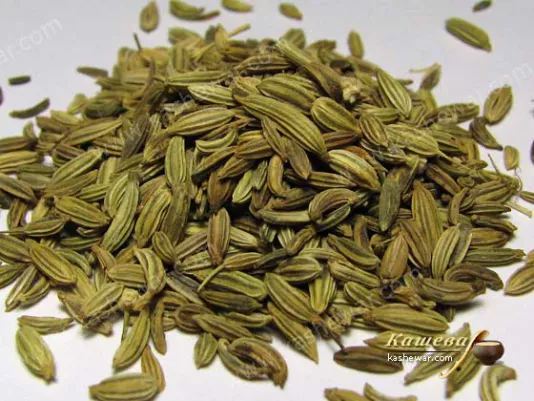Adjika
Adjika – a recipe for Georgian cuisine, this adjika is prepared without adding tomatoes, but on the basis of hot peppers and spices.

Fennel Seeds are one of those spices that teach respect for nuance. Their aroma doesn’t shout but unfolds gradually, creating depth and layers of flavor. Over the years, I’ve learned to sense the moment when the seeds are ready – when the kitchen fills with a warm, spicy haze and the grains turn brittle under the knife. Fennel suits both savory and sweet dishes: from baked fish or vegetables to bread with zest and honey, it always adds a soft, sweet freshness. Its essential oils promote digestion, so I often add a bit of crushed seeds to rich meat sauces or brew them in herbal tea after a hearty dinner. Combined with coriander, anise, or cardamom, fennel forms a refined bouquet that balances acidity and richness. I’ve realized that true aroma appears only when you take your time – fennel loves gentleness, warmth, and patience. It doesn’t tolerate haste but rewards care: every dish with fennel gains maturity, like well-aged wine, and leaves a pleasant lingering memory of its fragrance.
When choosing fennel seeds, I always pay attention to their aroma and color. The best ones are light green or greenish-golden, free from dust or dullness. If the seeds look faded or smell musty, they’ve lost their essential oils and won’t benefit your dish. I never buy spices in bulk if they’re openly displayed: air and light quickly strip away the aroma. It’s best when the seeds are stored in a glass jar with a lid or in airtight packaging with a valve. At home, I keep them away from moisture and direct sunlight, and to check freshness, I rub a few grains between my fingers – the scent should be sweet, slightly minty, with a hint of licorice. I’ve found that even a small batch bought fresh is better than a kilogram of old stock. That’s why I refresh my spices every few months and label the jars with purchase dates. This way, I always have a fragrant foundation for any dish. Because the quality of a spice is the first condition of its benefit.
Before adding fennel seeds to a dish, I always toast them in a dry pan – it awakens their essential oils. I do it over low heat so the seeds don’t burn and turn bitter. When the aroma intensifies and a light crackling begins, I remove the pan from the stove. Through practice, I’ve learned to distinguish the moment when the grain is still raw from when it fully opens its potential. If I use fennel in baking, I grind it only partially, leaving some whole seeds for texture. For marinades or pickles, the seeds can be crushed with a spoon or mortar – this helps release their flavor into the liquid more quickly. I never grind fennel in advance: its essential oils dissipate fast, and the spice becomes dull. I store the seeds whole and grind them right before use. This simple step greatly improves the final flavor, as fennel reveals itself only when given a fresh breath of warmth.
Temperature is the key to unlocking fennel seeds properly. Over the years, I’ve found that too much heat destroys their aromatic compounds. When roasting vegetables or meat, I add the seeds at the end of sautéing, so they just warm through. For bread or cookies baked at around 180°C (356°F), I mix fennel into the dough beforehand so the oils distribute evenly. In sauces and soups, it’s best to add the seeds after removing from heat – even a few minutes of boiling can flatten the flavor. In my kitchen, I use fennel as a balance marker: when a dish feels too rich or too sweet, a pinch of this spice “lifts” it. It’s also important to let the finished dish rest a bit – the warm environment helps the aroma settle. Over time, I’ve learned to sense this moment without a thermometer, guided only by smell and color. That’s when fennel works best, adding not just aroma but harmony.
Fennel seeds have a distinct yet flexible aroma, pairing beautifully with lemon, mint, garlic, turmeric, cumin, and even honey. I often add them to roasted root vegetables or citrus marinades for poultry – the fragrance becomes brighter but never overpowering. In fish dishes, fennel enhances the natural saltiness, while in bread it adds a refreshing note. Through experience, I’ve noticed that fennel helps tame the excess acidity of tomato sauces and gives them depth. When combined with mild spices like cardamom or coriander, it creates a balanced aromatic profile without sharp contrasts. It’s important to remember that fennel doesn’t get along with smoky spices like smoked paprika or chili, as it loses its delicacy. I enjoy creating my own blends: fennel, coriander seeds, and a bit of mustard – a universal base for vegetables, meats, or sauces. Because of its versatility, I consider fennel one of the most valuable spices in the kitchen.
Many people think fennel is easy to use, but it’s just as easy to ruin its flavor. The most common mistake is over-toasting the seeds. They darken instantly and turn bitter, so I always let the pan cool slightly before toasting. Another mistake is grinding too finely – the spice loses texture and ages quickly. Through practice, I’ve learned to cook “by scent”: when the aroma becomes too sweet, it’s time to stop. Another tip – never add fennel to fatty sauces without preheating it: the spice oils must dissolve evenly, or bitter spots of flavor will remain. It’s also crucial not to mix old and new seeds – the aroma becomes murky. I always perform a small test: rub a few grains and inhale – if the aroma is clean, fresh, and free of mustiness, the spice is ready. Quality control begins with respect for the ingredient: fennel rewards those who treat it with care.